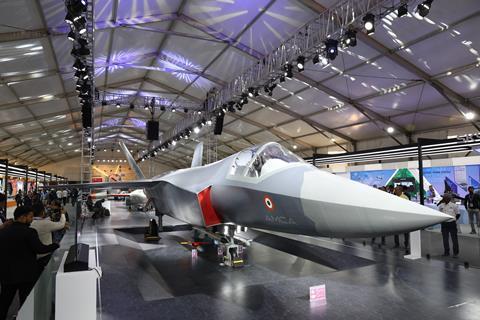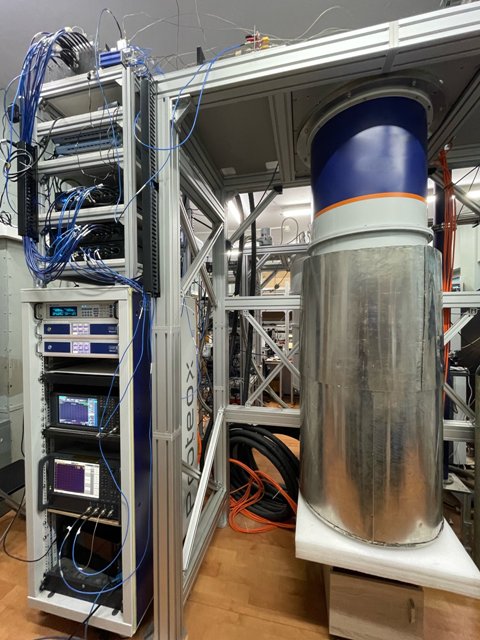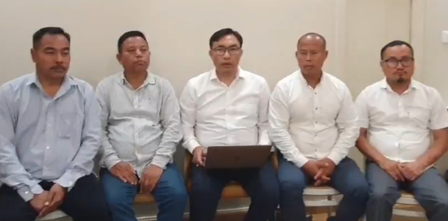SOURCE: RAUNAK KUNDE / NEWS BEAT / IDRW.ORG


India is actively exploring a strategic partnership with French aerospace firm Safran to co-develop advanced engines for the Tejas Mk-2 fighter jet, potentially replacing the General Electric (GE) F-414 engine initially selected for the program, according to a report by Moneycontrol. This move comes as negotiations between Hindustan Aeronautics Limited (HAL) and GE for establishing a production line for the F-414 engine in India, with 80% transfer of technology (ToT), have hit roadblocks over key technology transfer points.
The F-414 engine, intended to power the Tejas Mk-2, is a critical component for the indigenous fighter jet program, with the first locally produced engine expected to roll out within three years. However, unresolved issues in the HAL-GE discussions have prompted India to consider Safran as a viable backup plan. Safran has proposed the development of an enhanced M88-4 engine, a variant of the engine powering the Rafale fighter jet. This variant, tested for a thrust range of 95–105 kN (9,700–10,700 kgf; 21,000–24,000 lbf), is tailored for heavier single-engine fighters, making it a potential fit for the Tejas Mk-2.
Continue readingSOURCE: RAUNAK KUNDE / NEWS BEAT / IDRW.ORG


India’s Defence Research and Development Organisation (DRDO) is making significant strides in its indigenous jet engine program, with the Kaveri engine currently undergoing critical trials in Russia. The advanced turbofan engine, designed to power future Indian aerial platforms, is being tested for its suitability to drive a Made-in-India long-range Unmanned Combat Aerial Vehicle (UCAV), marking a pivotal step in India’s quest for self-reliance in defence technology.
According to sources, the Kaveri engine, developed by DRDO’s Gas Turbine Research Establishment (GTRE), is in the final stages of testing in Russia, with approximately 25 hours of trials remaining. The tests, conducted at specialized facilities in Russia, are subject to scheduling by local authorities, who allocate testing slots. These trials are crucial to validate the engine’s performance, reliability, and compatibility with the stringent requirements of a long-range UCAV, which demands high thrust, fuel efficiency, and operational endurance.
Continue readingSOURCE: RAUNAK KUNDE / NEWS BEAT / IDRW.ORG


In a significant development for India’s aerospace sector, a 120 kN indigenous engine is set to power the Advanced Medium Combat Aircraft (AMCA), marking a major milestone in the country’s pursuit of self-reliance in defense technology. According to sources, this ambitious project has overcome long-standing challenges and is now on the verge of becoming one of India’s most prestigious military aerospace programs.
For years, indigenous defense programs in India have faced significant obstacles, not due to a lack of funding, but rather the absence of unified will among stakeholders. However, the AMCA engine project has seen a renewed strategic thrust, with key domestic partners—GTRE (Gas Turbine Research Establishment), the Indian Air Force (IAF), CEMILAC (Centre for Military Airworthiness and Certification), and academic institutions—working in tandem. This collaboration has been pivotal in addressing past shortcomings and driving the project forward.
Continue readingSOURCE: AFI


On May 27, 2025, India’s Ministry of Defence, under the leadership of Defence Minister Rajnath Singh, made a historic announcement that reverberated across the global aerospace community: the formal approval of the execution model for the Advanced Medium Combat Aircraft (AMCA) program.
This milestone marks a decisive step in India’s quest to develop its first indigenous fifth-generation stealth fighter, a project that underscores the nation’s ambition to achieve self-reliance in defense under the Aatmanirbhar Bharat initiative. In an exclusive interview, former Indian Air Force (IAF) Chief Air Chief Marshal RKS Bhadauria joined me to discuss the significance of this development, the challenges ahead, and why India is betting on the AMCA over foreign alternatives like Russia’s Su-57 or the U.S. F-35.
Continue readingSOURCE: AFI


In a significant development for India’s air defense capabilities, Russia has reportedly offered the Indian Air Force (IAF) the R-37M, a hypersonic long-range air-to-air missile, to equip its fleet of Su-30MKI fighters. Known by its NATO designation AA-13 Axehead, the R-37M boasts a range of 300 to 400 kilometers and a top speed of Mach 6, making it one of the most formidable beyond-visual-range (BVR) missiles in the world. The offer, highlighted in posts on X and reported by sources like india.com and bulgarianmilitary.com, comes at a critical juncture as India seeks to bolster its air dominance amid regional tensions with Pakistan and China.
The R-37M, developed by Russia’s Vympel Design Bureau, is designed to neutralize high-value aerial targets such as Airborne Warning and Control Systems (AWACS), tanker aircraft, and enemy fighters, allowing the launching platform to remain outside the range of adversary defenses. Its jettisonable rocket booster enables the missile to achieve an extended range of 300–400 km (160–220 nautical miles), significantly outpacing India’s current R-77 missiles, which have a range of approximately 100 km. The missile’s hypersonic speed of up to Mach 6 (approximately 7,400 km/h) ensures rapid engagement of fast-moving targets, making it difficult for adversaries to evade.
Continue readingSOURCE: AFI
_202310161331382112_H@@IGHT_498_W@@IDTH_632.jpg)

The Philippine Marine Corps (PMC) has finalized its decision to configure its BrahMos supersonic cruise missile systems with a two-missile per Transporter Erector Launcher (TEL) setup, diverging from the Indian variant that employs a three-missile configuration. This strategic choice, driven by the unique geographical and infrastructural challenges of the Philippines, aims to ensure operational efficiency and adaptability across the archipelago.
The BrahMos missile, a joint Indo-Russian development, is a formidable weapon known for its speed (up to Mach 3), precision, and versatility in anti-ship and land-attack roles. Each missile weighs approximately 3 tons, and when paired with the 12×12 Tatra truck-based TEL, the combined weight of the Indian three-missile configuration poses significant challenges for the Philippines’ road and bridge infrastructure. Many roads and bridges in the country, particularly in remote and island regions, are not designed to support the heavy load of a fully loaded TEL carrying three missiles.
Continue readingSOURCE: AFI


Recent reports from Chinese local media, as exemplified by a Baidu article dated May 11, 2025, have escalated to unprecedented levels of exaggeration and distortion regarding the use of Chinese-made weapons in a supposed military conflict with India. The article, titled “Modi’s hometown was bombed? On May 11, New Delhi was bombed, Pakistani cruise missiles saturated bombing,” paints a fantastical and inflammatory picture of a military engagement that lacks credible evidence, raising serious questions about the intent and reliability of such propaganda.
The Baidu article alleges that on May 11, 2025, Pakistan, with Chinese support, launched 300 homemade drones to saturate New Delhi and strike Prime Minister Narendra Modi’s hometown. It claims that these drones, supported by Turkish military aid, operated for eight hours, tearing open India’s air defense network. The piece further asserts that Pakistan deployed Chinese-made “Silent Hunter” laser air defense systems, which supposedly achieved a combat loss ratio of 1:700,000, shooting down Israeli “Harop” drones at a cost of just $1 per engagement. According to the article, these systems, mounted on mobile platforms, used AI algorithms to destroy incoming drones within 20 seconds, outperforming India’s S-400 systems.
Continue readingSOURCE: IANS


Karnataka Deputy Chief Minister D.K. Shivakumar said on Tuesday that the state government would protect state’s assets at any cost in connection with relocating of the Hindustan Aeronautics Limited (HAL), the premier defence manufacturing industry run by the Centre and based in Bengaluru, to Andhra Pradesh.
Speaking to reporters at the Karnataka Pradesh Congress Committee office, Shivakumar said, “HAL has not been given by any BJP government. Former Prime Minister late Jawaharlal Nehru set it up in Bengaluru due to its technical manpower.”
Continue readingSOURCE: PIB


Defence Research and Development Organisation (DRDO) inaugurated the Quantum Technology Research Centre (QTRC) at Metcalfe House, Delhi on May 27, 2025. The facility was inaugurated by Secretary, Department of Defence R&D and Chairman, DRDO Dr Samir V Kamat with the aim to further strengthen indigenous quantum capabilities for strategic and defence applications.
QRTC is equipped with state-of-the-art experimental set-ups designed to propel research and development in critical quantum domains. The key capabilities of this centre include Characterisation of Vertical-Cavity Surface-Emitting Lasers and Distributed Feedback Lasers; Test-beds for evaluating single-photon sources; Set-up for characterisation of Micro Fabricated Alkali Vapor Cell; and Experimental platforms for developing and validating Quantum Key Distribution techniques to enable ultra-secure communication and safeguard national security in the post-quantum era, spearheaded by Scientific Analysis Group (SAG), DRDO.
Continue readingSOURCE: IANS


The Coordinating Committee on Manipur Integrity (COCOMI), the Meitei community apex body, held a meeting with the officials of the Ministry of Home Affairs (MHA) in New Delhi on Tuesday and reaffirmed its unwavering commitment to restore peace in the state.
The seven-member delegation of the COCOMI, led by its Convenor Khuraijam Athouba, during the meeting with the MHA officials, expressed its willingness to cooperate in all genuine efforts to restore normalcy.
Continue readingSOURCE: PTI


Jailed 26/11 Mumbai terror attacks accused Tahawwur Hussain Rana on Tuesday moved a court in New Delhi seeking permission to speak to his family.
The application, moved through Rana’s counsel, is likely to be taken up Wednesday before Special Judge Chander Jit Singh. The 64-year-old Pakistani-origin Canadian businessman is currently in judicial custody. Rana, a close associate of 26/11 Mumbai terror attacks main conspirator David Coleman Headley alias Daood Gilani, a US citizen, was brought to India after the American Supreme Court on April 4 dismissed his review plea against his extradition.Senior advocate Dayan Krishnan and Special Public Prosecutor Narender Mann represented the NIA.
Continue readingSOURCE: IANS


The final of Indian Premier League (IPL) 2025, scheduled to be held on June 3 at the Narendra Modi Stadium in Ahmedabad, will be dedicated to the Indian Armed Forces as a tribute to Operation Sindoor – the military operation carried out in response to the terror attack in Jammu and Kashmir’s Pahalgam, that claimed the lives of 26 civilians.
The Board of Control for Cricket in India (BCCI) and IPL Governing Council have decided to use the platform of the tournament’s finale to honour the armed forces and pay homage to the victims of the tragic incident.
Continue readingSOURCE: PTI


India has restarted the visa service for Afghanistan nationals wishing to visit the country for business, education and medical treatment and they can now apply online. After the Taliban seized power in August 2021, India withdrew officials from its embassy in Kabul and suspended visa services.
According to a notice put up on the government of India’s official visa portal , the visas will be given in the categories of business, student, medical, medical attendant, entry and UN diplomat.
Continue readingSOURCE: PTI


In a show of resilience, Jammu and Kashmir Chief Minister Omar Abdullah on Tuesday cycled on the streets of Pahalgam, alongside his two sons Zamir and Zahir, and interacted with people assuring them of revival of tourism.
This outing comes just over a month after the terrorist attack that claimed the lives of 26 people, mostly tourists, in the hill resort. The family’s cycling tour, spanning 2.5 kms, from a hotel to the base camp for the upcoming annual Amarnath Yatra followed a special cabinet meeting led by CM Abdullah.
Continue readingSOURCE: IANS


The Indian Navy is all set to welcome the triumphant crew of Navika Sagar Parikrama II on the successful completion of circumnavigation of the Globe onboard Indian Naval Sailing Vessel Tarini.
Accomplishing this rare feat in double-handed mode, young women officers of the Indian Navy, Lt Cdr Roopa A and Lt Cdr Dilna K, are set to touch the shores of Goa on May 29. This extraordinary sailing expedition was flagged off from the Naval Ocean Sailing Node, Goa, on October 2, 2024. Over a period of eight months, the Naval duo (famously called DilRoo) covered a distance of 25,400 nm (approx 50,000km) across four continents, three oceans and three Great Capes, braving extreme weather conditions and challenging seas relying solely on sails and wind power.
Continue reading